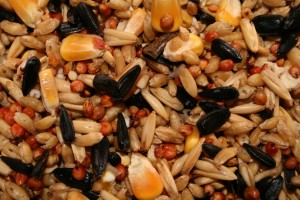 This article is the firies about seed saving. I’ll show you how to do it, and why to do it… because many modern seeds don’t grow well year after year.This means that if you value your independence or self-sufficiency, you have to buy new seed to plant every year.
This article is the firies about seed saving. I’ll show you how to do it, and why to do it… because many modern seeds don’t grow well year after year.This means that if you value your independence or self-sufficiency, you have to buy new seed to plant every year.
This is good for seed companies’ bottom line, but it’s bad for both your independence and your pocketbook. If you needed seed and the seed company wasn’t around to supply you, where would you go? Where would you get seed for the next growing season? What if the seed company didn’t have a variety suited to your climate or region? What if the seed companies ceased to exist?While some people feel comfortable buying seed year after year, many others have begun to save and share seed. Learning how to save your own seeds, especially from heirloom and locally adapted crops, frees you from dependence on seed companies. This gives you power over the future of your garden, the food you consume, and your ability to feed your family.
Seed saving is a very ancient tradition
In fact, saving seed is the very thing that made agriculture possible. Today, producing seed and saving seed is done by big business. In the past it was done by primitive people, who noticed which crop plants grew the best, and shook some of that plants seed into a bag. They would save this seed to plant the next season. Because many modern crops are very complicated, it’s easy to forget that the practice is just as simple and powerful as it was for our primitive forefathers.
Seed saving is an important skill both for the survival of people and the survival of the many crops that were bred over the centuries- “heirloom” varieties uniquely adapted to the conditions and stresses of the environment in which they originated. These crops typically breed true and offer unique solutions to nature’s problems; problems like drought, blight, insects, frosts, soil alkalinity, etc. Many of these crops represent thousands of years of careful observation and cultivation, and the primary way they have been, and will be preserved is through seed saving.
An accomplished seed saver will consistently have his own seed, uniquely adapted to his garden to plant year after year. If seed is selected and saved carefully, many gardeners can develop their own unique gene pools that are resilient, appropriate and productive.
Almost all crops can be cultivated from seed. Some are easy to select, harvest and save, while others are more difficult. To begin saving seed, a gardener must understand a few things:
Different crops live and reproduce on different timelines.
Annual shave short life-spans, germinating from seed, growing and reproducing in the course of a single summer. These crops are usually much easier to collect seed from year after year. There are many annual garden crops, including tomatoes, squash, corn, beans and lettuce.
Biennial crops germinate from seed one year, growing over the course of a growing season (this is called vegetative growth), overwintering, and then flowering and going to seed the following year. Good examples of biennials are beets and chard.
Perennial crops often survive for many years, and may flower and produce seeds every year once the crop is sexually mature. Many garden herbs, berries and fruits fall into this category.
This is important to understand what type of crop you are growing, because if you are waiting for a beet to flower the first year you will be very disappointed!
Seeds are produced by sexual reproduction.
This means that the offspring that result from seeds from a parent plant don’t always resemble the parent plant! Pollen from another type of plant may have fertilized the flowers on the parent plant, leading to strange looking crops. This is especially important to remember with crops like melons, cucumbers and squash as well as the many different varieties of peppers. Different varieties in these groups of plants cross readily. So, in order to control what kind of a plant the seed will grow, the pollination of some crops must be controlled by planting them far apart, or putting a screen around them to keep insects out.
Hybrid crops will typically not breed true.
Many modern crops are hybrids. Hybrids are stronger and bigger in the first generation because they have lots of genes. But, if two hybrids cross, then all of those genes cause the offspring to be very different from the parents. This means that the seed from hybrids is pretty useless, because you don’t know what you will get if you grow it.
Seeds are alive!
This means that seeds can be killed if they are not cared for properly. You must be careful with how you collect, dry and store your seeds or you will kill them.
Hope you enjoyed this primer – stay tuned for more specific info on seed saving techniques!
Source :http://www.survivopedia.com/
